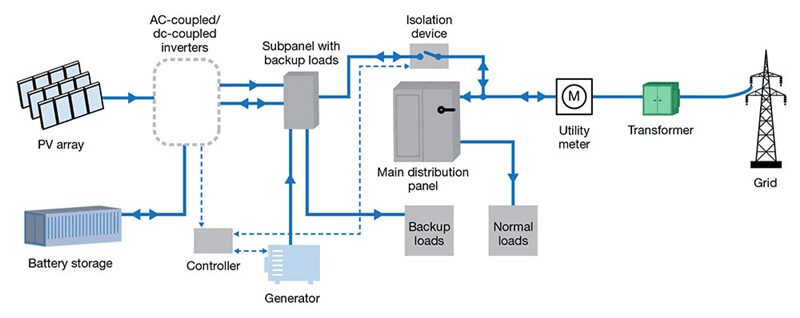What is Energy Security?
A prudent approach to managing any business encompasses strategies for controlling energy costs and ensuring energy demands can be met. When both long and short-term cost and risk are included in your strategy, you are beginning to talk about energy security. The International Energy Agency defines energy security as “the uninterrupted availability of energy sources at an affordable price.” This definition applies both on a national scale as well as at an individual business or a corporation-level. However, this article is focused on how corporations and individual businesses can get ahead on a path to achieving energy security and resiliency.
Short-term energy security for a business means being prepared for disruptions like natural disasters, grid disruptions or sudden price shocks. The long-term is characterized by transitioning away from less sustainable energy sources and those likely to steadily increase in price, and instead toward sources that will be more inexpensive, sustainable, and reliable in the future. A robust energy security plan will factor in both long and short-term elements to help companies prepare for things like outages, shortages, or sudden jumps in the price of a particular energy source. This helps ease the transition to more economically and environmentally sustainable energy sources. Reaching out to an experienced energy security consultant with a holistic energy security approach like Veregy will ensure an effective plan.
Efficiency vs. Resiliency
A necessary step to understanding energy security is integrating energy efficiency while moving beyond it to energy resiliency. Instead of considering simply how sustainable or reliable your energy source is, consider the long-term affordability as well. Instead of investing solely in renewable energy, build out real resiliency with energy storage, greater building efficiency, and a long-term plan. An energy security plan addresses future growth but also ensures short-term reliability in the case of outages or shortages, and is more active in long-term growth plans, including avenues for transitioning to cleaner and cheaper energy sources down the line. If you want to reach energy resiliency, putting together an energy security plan will put you on the right path.
Planning For Your Energy Security
For some organizations, the reasons to plan for energy security are core to their mission. Any interruption to energy availability is a huge issue which could cost millions of dollars or put lives at risk. Other business leaders with excellent foresight may be planning for a more unpredictable energy future or hedging against a likely increase in the price of their primary energy source. Others still are invested in sustainability and aim to set an example in their industry while securing long-term energy savings. Energy security affects everyone who purchases energy, from individual home-owners and small enterprises, all the way up to huge manufacturing facilities, retail locations, and logistics hubs. Preparing in the short-term for outages, price shocks, and natural disasters, while planning for long-term declines in the availability of particular fuel sources price increases is the key to a complete energy security strategy.
Needs and Risks: Begin Your Planning
If you have decided to take your organization’s energy security seriously, the best way to begin is by considering the specific needs and parameters of your operation. What are the specific energy sources you rely on? Is it a combination of natural gas and grid electricity? How is your grid electricity generated? Do you already have on-site energy generation? Once you are able to answer questions like these, consider the various risks inherent to your energy system. Is your plant or local utility vulnerable to natural disasters like flooding, fire, or storms? Are there long-term risks associated with your primary energy sources as in the case of coal or petroleum? Are there other predictable regulatory or economic issues that will influence your energy system? Once you have an energy needs and risks assessment tailored to your location and organization, you can begin building an energy security plan.
Components of an Energy Security Plan: On-Site Solar Power
Your Energy Security Plan begins with a needs assessment. The next step is ensuring you are able to meet these needs over time at a reasonable cost. One of the best ways to ensure this is through diversifying your energy sources, including on-site energy generation. A good first step is investigating the viability of on-site power generation with solar PV. Solar power is rapidly advancing in efficiency and affordability, and can immediately impact your bottom line. Capital structures including tax assessed programs like Property Assessed Clean Energy (PACE) are well-developed and offer attractive financing options for many businesses interested in investing in solar generation. Conversely, solar does require plenty of space, and depending on your energy needs and availability of real estate, it may not completely cover your energy demand. Solar is a great first step but is likely not sufficient on its own to make your business energy secure.
Components of an Energy Security Plan: On-Site Cogeneration
Another on-site power generation source that is a good complement to solar power is cogeneration. The key to a cogeneration system is combined energy and heat production and using the integration of these systems to maximize efficiency. Cogeneration systems can use a variety of fuel sources, including natural gas, biomass, or biogas. Choosing which fuel source and which type of cogeneration system to use will depend on how much energy you need and the availability of a given fuel source. Some organizations like manufacturers or large institutions can see huge efficiency upsides from combined heat and power systems, while others may use cogeneration as a partial or backup energy source, in conjunction with a wider energy security plan. Depending on the requirements of your facility, you may need a different cogeneration system.
Energy Storage and Backup Power
Building out on-site energy generation is integral to energy security, but generation is only half the battle. In order to be fully prepared for the many long and short-term challenges to maintaining access to reasonably priced energy, a business should consider an energy storage system. Battery technology has come a long way in a short while, and when implemented wisely, an energy storage system can immediately bring down your energy costs through peak-shaving. Having an energy storage system is one way to ensure energy availability during an outage or disruption. When used in combination with a renewable on-site power source such as solar PV, instead of a more traditional diesel backup generator system, you can avoid dependence on fossil fuel and the associated pollution, grime, and noise.
Putting It All Together: Microgrids
Each of these energy security measures is valuable as a stand alone component, but the true advantage comes from intelligently deploying them together. It may sound complicated to manage multiple on-site energy sources, energy storage, fuel procurement, and grid interactions and metering, but microgrid technology is here to make it happen. A microgrid not only reduces your energy cost, but it is also the most reliable contingency for when unexpected blackouts, brownouts, or surges happen. Total energy security and true energy resiliency can be realized when you combine on-site renewable energy, cogeneration, power storage, and a smart microgrid system to balance and manage the entire system. If grid power is lost, you have diverse backup sources and storage capacity. If prices spike or shortages occur, you have redundancy and flexibility. Finally, if energy policies shift, if a carbon tax is introduced, if a sea change in the way that we procure and generate energy occurs, your system will be ready.
The Military Leading on Energy Security
The US Military is setting a strong example of building energy security on the installation-scale by employing more energy efficient systems, creating renewable energy generation sources, and building out energy storage on-base. By using this multi-pronged approach, military installations in the US and abroad are prepared for disruptions to grid infrastructure due to weather, natural disasters, equipment failures, or human error. At the same time, these systems allow for a steady transition away from fossil fuel dependence, which is becoming economically as well as environmentally unviable as a long-term energy source. The U.S. Military’s operations are vital—they cannot afford not to invest in their energy security. As climate change continues to impact energy production, destabilize weather systems causing more natural disasters, and ultimately force a massive energy transition, energy security is becoming essential to the private sector as well.
Getting Started
Regardless of whether you are a food manufacturer or school system, a shopping mall or an Air Force base, an apartment building or a foundry, you need energy security. The face of energy production is changing as rapidly as the world it powers is changing, and being ready for that change means ensuring you can afford to keep the power flowing. A full microgrid system as depicted above is not appropriate for all buildings or plants, but careful consideration of energy security is essential. One should consider reaching out to a firm with a wealth of experience and expertise in building energy security and resiliency like Veregy as a first step. Professional engineers and energy experts can help you assess your needs and risks, and provide the proper planning for any future energy disruption.


